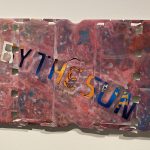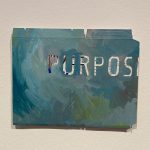









Initial Thoughts
The work was presented about one arm’s length apart at eye level. At first glance, they resemble traditional fine art placement (of paintings mainly) but instead of one large piece, there were 10 different pieces spread across two walls. The fusion of acrylic painting and found material such as paper envelopes and cardboard gave the series a rather refined touch, contrasted by the off-centered text that dominated each of the paintings. I was really intrigued by the contrast, as it resembled a collage of sorts. Collages are well-thought albeit improvised (most of the time) pieces that reflect a person’s thoughts and personality. The text appears layered due to the cut – out pieces of magazines and tabloids.
Contemplations
Time Passes resonated with me in more ways than I could imagine. The exhibition showcased the transformation of everyday items, activities and spaces over the course of the pandemic. I’ve always wondered how things would change due to the pandemic. Will we ever be able to return to our ‘carefree’, mask-less and intimate ways of interaction that we have taken for granted? The answer is indeterminate. I enjoyed the series of artworks that encapsulated the concept of time and how time acts on the past and present. Re-expression of our beings, whether through subtle or drastic re-imagining of spaces and materials, continue to drape over the reality of our situation.
Of the many artworks present in the Time Passes exhibition, Mengju Lin’s series of 10 artworks invites us to look at the paintings with a new perspective. 10 coherent artworks, each having different names and texts (as listed above), are juxtaposed with varying effects and context. Personally, I feel that there is no need for complication; the artists leaves us to define the objects in whatever way we like. There is no fixed solution, estranged texts brought out of context intentionally, allowing us to form our own interpretations and adapt our minds to the objects. Simplicity worked well for the artist, who sought to blend familiarity and novelty. As we hope for time to heal us from the pandemic, care and compromise have been exercised, albeit in a much different way from before. In light of this, our compromise create subtleties and nuances in future practices and it would be inappropriate to say that we can return/resume our normal lives. The new normal, though undesirable to most, is likely here to stay in either shape or form.
